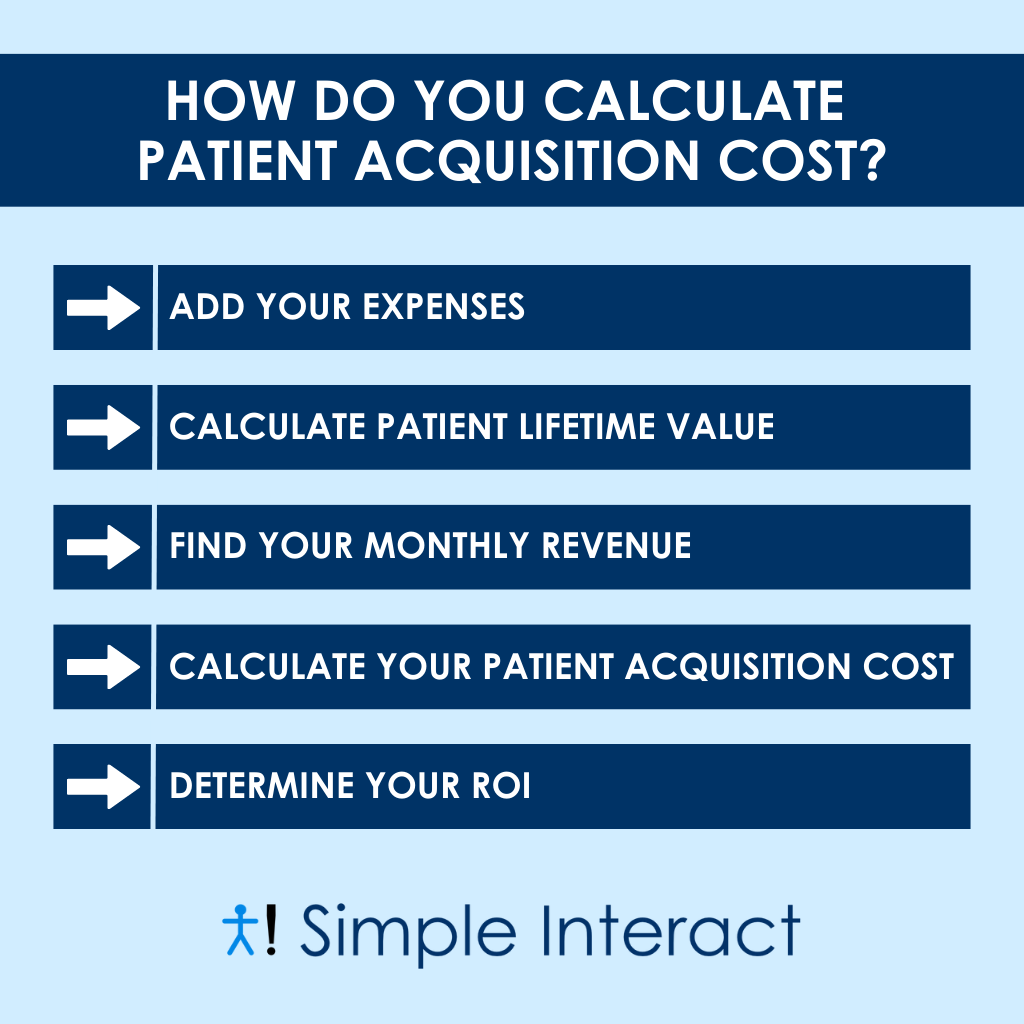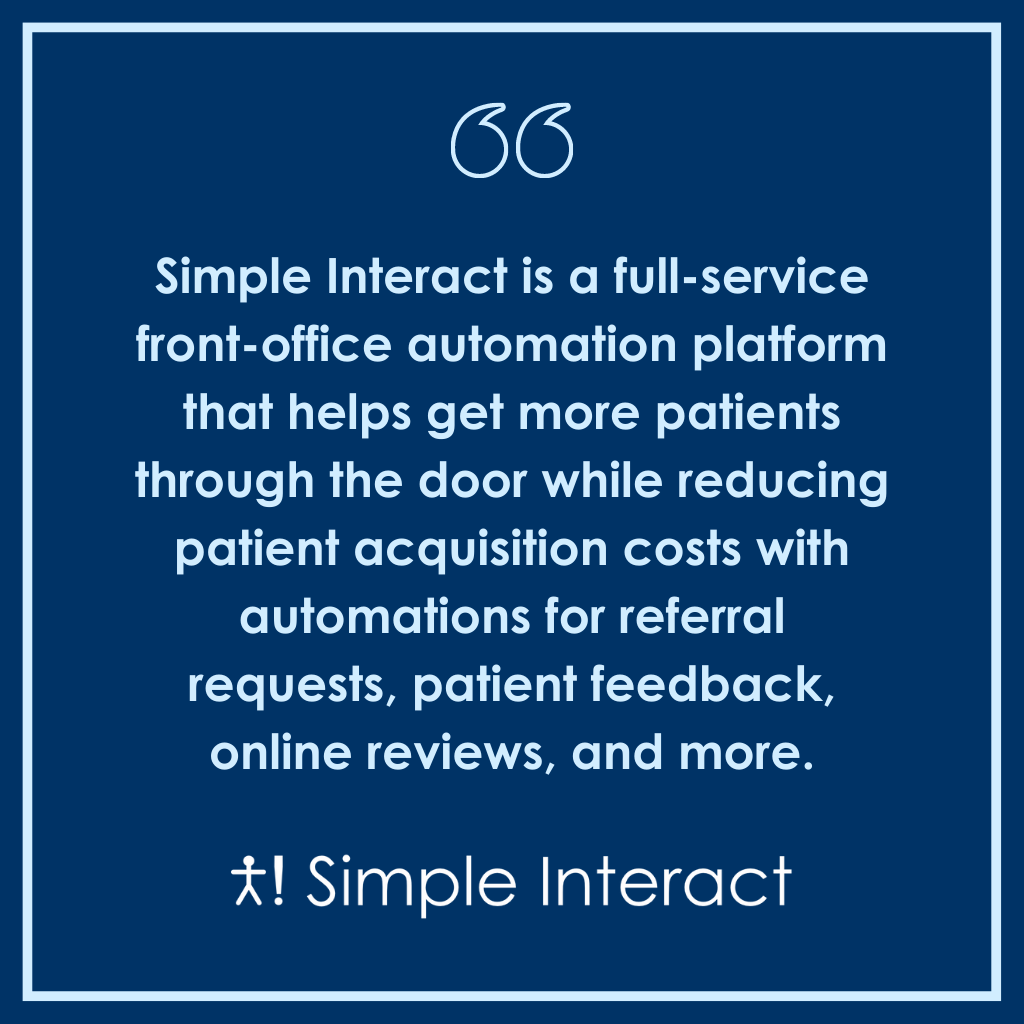How to Calculate and Reduce Your Patient Acquisition Cost

New patients are crucial for any healthcare facility’s business, but even more so for specialists.
For specialists, patients often come in only for episodic needs; they aren’t regular visitors once their problem is solved. The office brings in revenue from their appointments or procedures, but these don’t make up an ongoing revenue source. For this reason, new patients are the lifeblood of specialist facilities.
For a thriving specialist practice, new patient visits make up about 20–40% of business. An important question, then, is how to foster a steady stream of new patients to ensure your organization stays profitable.
Which channels bring in new patients? Which are less successful? And what is your patient acquisition cost?
Where Does Most New Patient Acquisition Come From?
Most healthcare facilities receive their new patients through two primary sources: referrals and online research.
Referrals
Referrals make up the bulk of new patient acquisitions, and they can come from various places, depending on your specialty. Insurance companies, primary care physicians, friends, or associated institutions, like schools or sports training facilities, are the most notable referral avenues for most healthcare organizations.
It’s important to have an effective referral management process to reduce referral leakage and ensure it’s as easy as possible for others to refer patients your way. Read our blog post on the subject to learn more about the capabilities every referral management process should have for a seamless, effective process.
Online Research
People may recognize they need a specialist even without a referral and do their own online research to find one. Besides provider qualifications, one of the top factors these patients will consider is a facility or provider’s online reputation.
Typically, you want at least 10% of your business to come from new patients finding you online. It’s crucial to have great reviews from past and existing patients to maintain (or increase) this percentage.
In fact, online reviews even affect the business you acquire through referrals. If a physician refers their patient to a specialist, or if an insurance company provides a list of specialists, today’s patients very often still look up that specialist online. If they see good reviews, then they’re happy with the referral. If they see bad reviews, they may ask for a new recommendation.
What Is Patient Acquisition Cost?
If new patients come from referrals and online reputation, then new patient acquisition cost is the amount you spend on these two business initiatives. The following expenses are usually associated with your overall patient acquisition cost.
Referral Marketing Costs
Healthcare organizations may hire a marketing person to establish, build, and strengthen relationships with referral sources.
This person (or people) often reaches out to potential referral sources, establishes relationships, and meets up for lunches or learning sessions. They may also share marketing materials and helpful information with each source about why, when, and how to send referrals to your facility. Every aspect of this kind of initiative involves a cost.
Referral Management Costs
Once you have a referral, the next step is to convert that into an actual appointment. This involves paying your scheduling staff or a referral management team to handle referrals and ensure referrals become appointments.
The salaries of these employees, or at least a portion of their salaries, should be factored into your patient acquisition cost.
Online Reputation Management
While patients may occasionally leave reviews without any prompting, actively building your online reputation requires strategy and intentional investment.
Maybe you give each new patient a business card with a QR code that directs them to where they can leave a review online. Or, you may hire an outside agency to manage your reviews, listings, and online reputation. You may even purchase software that requests reviews from existing patients. These are all expenses that should be factored into your patient acquisition cost.
Online Presence
It’s critical to have an online presence so potential patients can easily find you, learn about you, educate themselves with valuable material, and reach out to book an appointment with you. In addition to a website, you may also need a presence on Google, Facebook, and other search or social media sites.
The expenses for producing and/or maintaining these resources also contribute to patient acquisition costs.
Advertising
Do you pay for radio, internet, social media, or print advertising? Do you hire a marketing agency (or pay someone internally) to create blogs, newsletters, emails, brochures, or other marketing content for your business? If so, remember to factor these into your patient acquisition cost as well, since these items all focus on attracting new patients.

How Do You Calculate Patient Acquisition Cost?
The cost of acquiring a new patient may seem rather ambiguous at first, but it’s actually pretty straightforward to calculate. Follow these steps to determine your patient acquisition cost.
Add Your Expenses
First, add the expenses of all the items listed above to determine the total amount you spend on patient acquisition. This total may include some (or all) of the following:
- Salaries for your referral management staff, scheduling staff, and marketing employee(s)
- Budget for marketing materials and events for patients and referral sources
- Software expenses for managing website, online reviews or referrals
- Advertising expenses for online advertising and content marketing
For example, imagine an orthopedic specialist spends $4,000 on related salaries, $1,000 on marketing materials and events, $1,500 on software, and $750 on monthly advertising expenses. That monthly patient acquisition expense would be a simple addition problem: $4,000 + $1,000 + $1,500 + $750 = $7,250.
This practice spends $7,250 on patient acquisition per month.
Calculate Patient Lifetime Value
Next, you’ll want to calculate your patient lifetime value (Patient LTV). This value estimates the amount of revenue the future relationship with each new patient will generate. For example, the abovementioned orthopedic specialist may determine the following:
- 20% of new patients will elect for surgery at $3,000 on average per surgery and four office visits at $250 per visit.
- 80% of new patients will make two office visits at $250 per visit.
To calculate the Patient LTV for this specialist, you would complete the following calculation: ((20 x $3,000) + (20 x 4 x $250) + (80 x 2 x $250)) / 100 = $1,200.
On average, each new patient will generate $1,200 in revenue during their relationship with this practice.
Find Your Monthly Revenue
Once you determine the Patient LTV, you can use this number to calculate the monthly revenue added by your new patients.
For example, this orthopedic practice’s net revenue is $1,200 per new patient, and it sees 35 new patients monthly. To calculate the total revenue added by new patients per month, they would complete the following equation: 35 x $1,200 = $42,000.
The total revenue added by new patients in one month is $42,000.
Calculate Your Patient Acquisition Cost
At this point, you can use these amounts to calculate your patient acquisition cost by dividing all your patient acquisition expenses by the number of new patients you see. So, for this example, this amount would be calculated using the following equation: $7,250 / 35 = $207.
It costs $207 to acquire a new patient, but when you have an average Patient LTV of $1,200, that’s a great sign! For every new patient, you’re making a profit of $993. Your patient acquisition cost should always be lower (ideally, much lower) than the Patient LTV, and for this practice, it is.
Determine Your ROI
Finally, calculate your return on investment (ROI) for patient acquisition by subtracting the total patient acquisition cost from the revenue and dividing it by the expenses. For this practice, the equation would be ($42,000 – $7,250) / $7,250 = 4.79.
When you multiply this number by 100%, this practice has an ROI of 479% on patient acquisition, which is excellent.

How Do You Reduce Patient Acquisition Cost?
Imagine you finish calculating your patient acquisition cost and realize you’re spending way more on acquiring each new patient than what those patients bring in (Patient LTV). In that case, you’ll need to explore ways to reduce your patient acquisition expenses to boost your ROI and make your facility more profitable.
One of the best ways to lower your patient acquisition cost is with automated software. A significant expense for patient acquisition is staffing — paying your marketing department, referral management staff, scheduling staff, and more. While you’ll still need some (if not all) of these positions filled, review management platforms streamline processes and improve efficiency significantly. Employees need fewer hours (and perhaps fewer hands) to do their work, and they can dedicate their time elsewhere.
Automation doesn’t just improve your bottom line — it can also improve your top line. Automation improves your online reputation by encouraging patients to leave reviews, which gets more patients through the door at a lower cost. You can also invest in referral management software to reduce referral leakage, so you can ensure every referral you pay for becomes an appointment at your office.
Another very effective way to reduce patient acquisition costs is to capture “how did you hear about us?” data in your new patient intake process. This data helps you identify which channels are working and which channels to spend less on. You’ll gain greater insight into your acquisition process and increase the mileage of your marketing dollars.
Keep Patient Acquisition Cost Low and ROI High With Simple Interact
Simple Interact is a full-service front-office automation platform that helps get more patients through the door while reducing patient acquisition costs with automations for referral requests, patient feedback, online reviews, and more.
Learn more about the solutions we offer to help improve your healthcare organization’s bottom line, top line, and everything in between.

Ravi Kalidindi is the Founder and CEO of Simple Interact, a leading Front Office Automation company that helps healthcare facilities across the United States run more efficiently and profitably by boosting staff productivity, reducing provider burnout, and elevating the patient experience. Customers view Ravi as a trusted partner who can quickly comprehend business problems and suggest “keep it simple” solutions that are effective and easier to maintain over time.
Recent Posts
- The Benefits of Using 2-Way SMS Chat for Healthcare Communication
- 2-Way SMS vs. Live Chat: Which Is Best for Bi-Directional Patient Communication?
- Simple Interact Earns A+ Satisfaction Ratings in KLAS Report
- Boosting Healthcare Staff Productivity With a Shared Inbox Dashboard
- Healthcare SMS: What Metrics to Track in Your 2-Way SMS
Categories
Archives
- February 2025
- June 2024
- May 2024
- April 2024
- March 2024
- February 2024
- January 2024
- December 2023
- November 2023
- October 2023
- September 2023
- August 2023
- July 2023
- June 2023
- May 2023
- April 2023
- March 2023
- February 2023
- January 2023
- December 2022
- November 2022
- October 2022
- September 2022
- August 2022
- July 2021
- December 2020
- May 2020
- March 2020
- June 2016